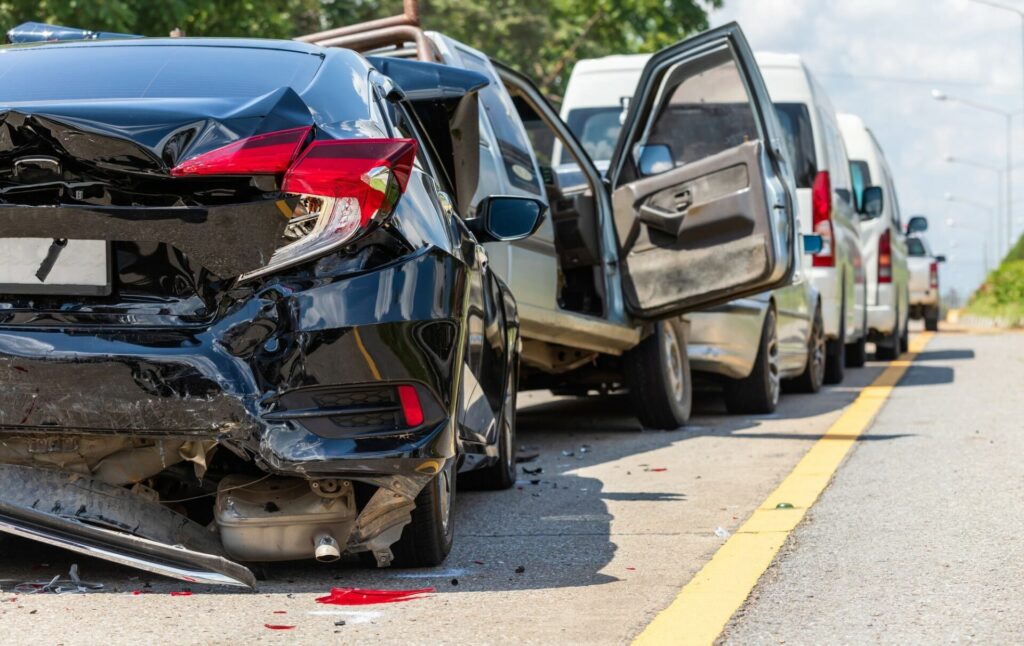Yes — if you feel any pain after being rear-ended, you should seek medical care today. Delayed pain is very common after rear-end crashes in California, and getting checked immediately protects your health and your legal claim.
Why this matters right now
Rear-end collisions are the most frequent car crashes in Los Angeles and across California. Even “minor” fender-benders can cause serious neck, back, head, and soft-tissue injuries that don’t fully show up until hours or days later.
The adrenaline spike after a crash can temporarily mask symptoms. That’s why same-day medical evaluation is essential, even if you feel “okay” at the scene.
Immediate care does three critical things:
-
Protects your health. Doctors can catch internal or musculoskeletal injuries before they worsen.
-
Creates proof. Medical records from Day 1 show that the crash caused your injuries.
-
Prevents insurance tricks. Adjusters love to argue that “you must not have been hurt” if you didn’t see a doctor immediately.
Bottom line: In California rear-end accidents, no same-day care = a weaker claim. Don’t give the insurance company that opportunity.
Common injuries after rear-end crashes (even at low speeds)
-
Whiplash / cervical sprain-strain. Rapid head “snap” injures muscles, ligaments, and discs. Pain, stiffness, headaches, and reduced range of motion are classic.
-
Concussion / mild traumatic brain injury (TBI). You do not need to hit your head to get a concussion. Watch for headaches, fogginess, nausea, light sensitivity, memory issues, or mood changes.
-
Herniated or bulging discs. Cervical, thoracic, or lumbar discs can shift or tear, causing shooting pain, numbness, or weakness down arms or legs.
-
Facet joint injuries. These small spinal joints can become inflamed, causing sharp, localized pain that worsens with certain movements.
-
Shoulder/knee injuries. Seat belt and bracing can injure the shoulder; dashboard contact or bracing can injure knees (meniscus, sprain/strain).
-
Myofascial pain / soft-tissue damage. Microtears and trigger points can cause lingering pain and spasms.
-
TMJ (jaw) dysfunction. Jaw can misalign from the whiplash motion, causing clicking, pain, or headaches.
-
Psychological trauma. Anxiety, sleep disturbance, and driving avoidance are common and treatable.
Remember: low property damage ≠ low injury risk. Your body absorbs forces differently than metal and plastic.
Red-flag symptoms—go to the ER or urgent care today
-
Severe neck or back pain
-
Numbness, tingling, or weakness in arms or legs
-
Worsening headache, confusion, slurred speech, repeated vomiting
-
Loss of consciousness (even briefly) or memory gaps around the crash
-
Chest pain, shortness of breath, or abdominal pain
-
Loss of bladder/bowel control
-
Severe dizziness or vision changes
-
You are pregnant, elderly, or you have a bleeding disorder / are on blood thinners
If you have any of these, seek emergency care immediately.
“I feel sore but it’s not terrible. Should I still see a doctor today?”
Yes. Here’s why:
-
Delayed onset is normal. Inflammation builds over 24–72 hours; soreness tonight can be significant tomorrow.
-
Early treatment shortens recovery. Prompt anti-inflammatory measures, imaging (as needed), and a specialized care plan reduce complications.
-
Paper trail matters. California insurers look closely for “gaps” in treatment to downplay your pain.
Action step: If you don’t need the ER, visit urgent care or a same-day primary care clinic today. If your symptoms persist, follow up with your PCP, an orthopedic specialist, or a concussion clinic as appropriate.
What to do in the first 24–72 hours (simple checklist)
-
Get examined today. ER, urgent care, or same-day clinic. Mention the crash and every symptom (even “minor” ones).
-
Tell the truth, tell it all. Be complete and consistent. “Neck stiffness, headache, and lower-back twinge” is better than “just a little sore.”
-
Follow medical advice. Fill prescriptions; start recommended therapies.
-
Document everything. Photos of bruising/seat-belt marks; daily pain journal (1–10 scale); missed work; activity limits.
-
Don’t self-diagnose. Avoid heavy lifting, intense workouts, or stretching that increases pain until cleared.
-
Avoid recorded statements to insurance. Speak to a lawyer first.
-
Call us. We’ll help coordinate care, protect your claim, and deal with insurers while you heal: 818-784-8544 (24/7) or live chat/text.
Which doctor should I see?
-
ER / Urgent Care: For red-flags or significant pain, numbness, dizziness, or head injury concerns.
-
Primary Care Physician: For initial evaluation and referrals to specialists, PT, imaging.
-
Orthopedic Spine / Physiatry: For disc/facet injuries, radiculopathy (shooting arm/leg pain), interventional pain options.
-
Concussion / Neurology: For head injury, cognitive changes, headaches, or visual issues.
-
Physical Therapy / Chiropractic / Massage: Restores movement and reduces pain; must be coordinated and documented.
-
Behavioral Health: For anxiety, PTSD-type symptoms, or sleep disturbance.
We routinely help clients find the right specialists in Los Angeles, the Valley, Inland Empire, Orange County, and throughout California. If transportation or cost is an issue, ask us about assistance and medical liens.
What imaging or tests might you need?
-
X-rays: Rule out fractures or dislocations.
-
MRI: Evaluates discs, nerves, ligaments, and soft tissue (often not done Day 1 unless indicated).
-
CT scan: For suspected fractures or certain head injuries.
-
Neurocognitive testing / Vestibular assessment: For concussion symptoms.
-
EMG/NCS: Later, to assess nerve involvement.
Imaging is clinically driven—not everyone needs an MRI immediately. Your doctor decides based on symptoms and exam.
California insurance basics after a rear-end collision
-
Bodily Injury Liability (at-fault driver): Pays your damages up to their limits.
-
MedPay (Medical Payments) coverage: Optional coverage under your auto policy that pays medical bills regardless of fault (often $1,000–$10,000+).
-
Health Insurance: Can be used; your insurer may later seek reimbursement from the settlement (subrogation).
-
Uninsured/Underinsured Motorist (UM/UIM): If the at-fault driver has low or no coverage, your UM/UIM can step in.
Tip: Do not let an adjuster rush you into a quick settlement “for medicals only.” You settle once. If symptoms worsen later, there’s no redo.
“Gaps in treatment” and why insurers use them against you
-
First gap: Not seeing a doctor the day of the crash or next day.
-
Ongoing gaps: Missing follow-ups or long breaks between visits.
-
Perception: They argue you weren’t really hurt, or something else caused your pain.
Solution: Seek care day-of, keep appointments, and follow your provider’s plan. If you must miss an appointment, reschedule immediately and document why.
How we help you build a strong California injury claim
We focus on proof:
-
Immediate documentation: ER/urgent care records, photos, body-diagram of pain.
-
Consistency: Your medical history, pain journal, and provider notes align.
-
Objective findings: Imaging or exam findings that support your symptoms.
-
Impact evidence: Time off work, activity limitations, caregiver help, and lifestyle changes.
-
Future care: If injuries are ongoing, we obtain provider opinions on future needs and costs.
-
Negotiation leverage: We assemble a demand package that tells the full story—with evidence—so adjusters know lowballing won’t work.
California legal timelines you should know
-
General statute of limitations: Most California personal injury claims must be filed within 2 years of the crash.
-
Government claims (public entities): You must file a government claim within 6 months of the incident (short and unforgiving deadline).
-
UM/UIM deadlines: Policy-specific notice requirements apply and can be short.
Don’t wait. The sooner we’re involved, the stronger your case positioning.
Do’s and Don’ts after a rear-end accident in Los Angeles (and statewide)
Do:
-
Get medical care today and follow the plan.
-
Photograph vehicle damage, your injuries, and the crash scene if possible.
-
Save receipts, prescriptions, and out-of-pocket costs.
-
Keep a daily pain and limitations journal.
-
Call a California rear-end accident attorney early (818-784-8544).
Don’t:
-
Give a recorded statement to the other driver’s insurance.
-
Post about your crash or injuries on social media.
-
“Tough it out” and skip care—insurers will use it against you.
-
Ignore mental health symptoms (they’re real and compensable).
How compensation works in rear-end injury cases
Your claim may include:
-
Medical bills (past and future)
-
Rehabilitation/therapy
-
Lost wages / diminished earning capacity
-
Pain, suffering, and loss of enjoyment of life
-
Property damage
-
Out-of-pocket costs (meds, travel to appointments, etc.)
We pursue every available source of recovery (at-fault driver, employer if on-the-job, rideshare/trucking insurers, UM/UIM, etc.).
Special situations: teens, seniors, pregnancy, and rideshare/trucking
-
Teens & seniors may under-report pain or feel slower recoveries—early evaluation is vital.
-
Pregnancy: Always get immediate obstetric guidance; even minor trauma requires caution.
-
Rideshare (Uber/Lyft) & delivery/trucking collisions involve layered commercial policies and strict notice rules—talk to us ASAP so evidence isn’t lost (dashcam data, EDR/black box, app logs).
Recovery timelines: honest expectations
Soft-tissue injuries can improve within weeks if treated early and consistently. Disc and nerve injuries can take months and sometimes require interventional care. Concussions vary widely; returning to exercise or work should follow medical guidance. Fast, consistent care = better outcomes and stronger claims.
Why choose The Law Offices of Gerald L. Marcus
-
Los Angeles-based, statewide reach: We handle cases throughout all of California and can come to you.
-
No fee unless we win. You pay nothing up front.
-
Medical coordination: We help connect you with reputable providers and manage medical liens.
-
Aggressive negotiation & litigation: We don’t accept lowball offers.
-
Available 24/7: 818-784-8544 or live chat/text.
Call now: 818-784-8544 • Free consultation • We’ll handle the insurance; you focus on healing.
FAQs
Q: I feel fine after being rear-ended. Should I still see a doctor?
A: Yes. Delayed pain is common. Same-day evaluation protects your health and creates the medical documentation your claim needs.
Q: How long after a rear-end accident can pain start?
A: Immediately up to 72 hours (or longer) as inflammation develops and muscles tighten.
Q: What injuries are common in rear-end crashes?
A: Whiplash, concussions, herniated/bulging discs, facet injuries, shoulder and knee injuries, TMJ, and soft-tissue damage.
Q: Will not seeing a doctor right away hurt my case?
A: Yes. Insurers argue delayed care means a minor or unrelated injury. Get checked today.
Q: Can I use my health insurance or MedPay?
A: Usually yes. MedPay can cover early bills; health insurance can also be used. We help sort reimbursements later.
Q: How long do I have to file a claim in California?
A: Generally 2 years from the crash; government claims are 6 months. Don’t delay.
Q: What if the other driver has little or no insurance?
A: Your UM/UIM coverage may apply. We’ll review all policies to maximize recovery.
Q: Do I need a lawyer for a rear-end accident?
A: If you have pain, medical treatment, missed work, or long-term symptoms, a lawyer helps protect you from insurer tactics and increases the likelihood of full compensation.
Simple next steps (today)
-
Get medical care now. ER/urgent care/clinic as needed.
-
Call us at 818-784-8544. Free consultation, no obligation.
-
We handle the rest: Property damage, rental car, medical coordination, claim investigation, and negotiations.
You focus on getting better. We’ll fight for the result you deserve.
If you’re in pain after being rear-ended anywhere in California, get medical care today—then call The Law Offices of Gerald L. Marcus at 818-784-8544 or use our live chat/text. No fee unless we win. We’re ready to protect your health, your rights, and your recovery.


 We Don’t Back Down. We Dominate. Over $450 Million Won for Injury Victims.
We Don’t Back Down. We Dominate. Over $450 Million Won for Injury Victims.
